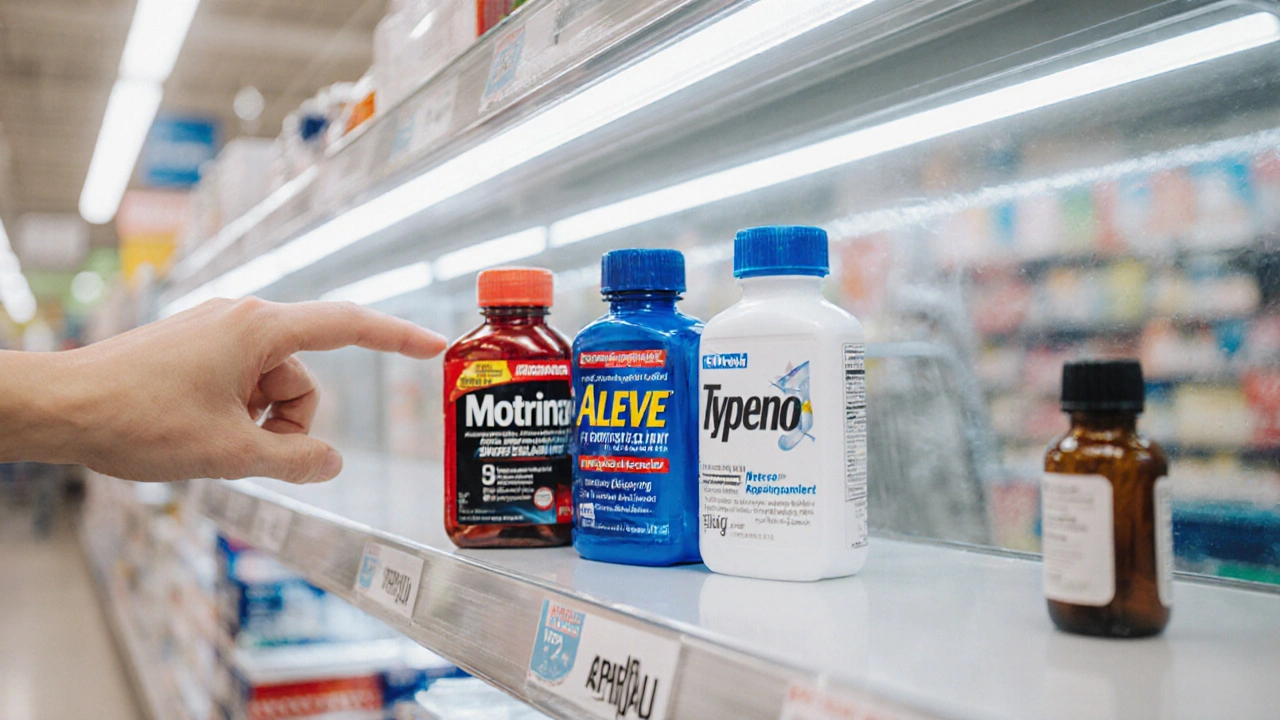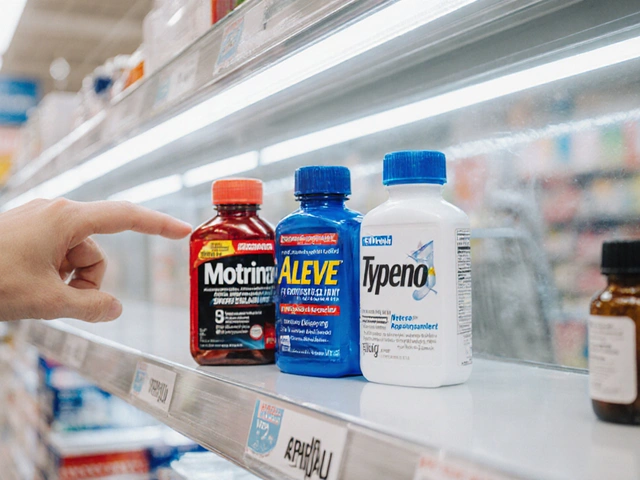When you reach for a bottle of pain reliever, the sea of brands and generic names can feel overwhelming. You might wonder whether Motrin vs alternatives matters for that headache, sore muscle, or fever. This guide cuts through the jargon, lines up the most popular options, and helps you pick the right one for your specific situation.
Key Takeaways
- Motrin’s active ingredient, ibuprofen, is a non‑steroidal anti‑inflammatory drug (NSAID) that reduces pain, fever, and inflammation.
- Alternatives such as naproxen (Aleve), acetaminophen (Tylenol), and aspirin differ in onset speed, duration, stomach‑impact, and ideal use cases.
- For short‑term pain with low stomach‑risk, ibuprofen often wins; for longer‑lasting pain, naproxen may be better.
- Children, pregnant women, and people with kidney or heart issues need special dosing guidance regardless of the product.
- Price and insurance coverage vary widely, so checking generic options can save you money.
What is Motrin?
Motrin is a branded formulation of ibuprofen, a widely used NSAID that works by inhibiting cyclo‑oxygenase enzymes (COX‑1 and COX‑2). This inhibition curbs the production of prostaglandins, the chemicals responsible for pain, fever, and inflammation.
How Ibuprofen Works
Ibuprofen, the active molecule in Motrin, reaches peak blood levels in about 30‑60 minutes after oral intake. Its half‑life is roughly two hours, meaning you’ll typically need a dose every 4‑6 hours for continuous relief. Because it blocks COX‑1 as well as COX‑2, it can irritate the stomach lining, especially at higher doses.

Popular Alternatives at a Glance
Below are the most common over‑the‑counter (OTC) pain relievers you’ll encounter in a pharmacy:
- Naproxen - sold as Aleve, a longer‑acting NSAID.
- Acetaminophen - marketed as Tylenol, a non‑NSAID analgesic and antipyretic.
- Aspirin - a salicylate NSAID often used for heart‑health low‑dose regimens.
- Diclofenac - a prescription‑strength NSAID found in topical gels and oral tablets.
- Meloxicam - a prescription NSAID with a longer half‑life, used for chronic arthritis.
Side‑by‑Side Comparison
| Drug | Typical OTC Dose | Onset (minutes) | Duration (hours) | GI Risk | Best For |
|---|---|---|---|---|---|
| Ibuprofen (Motrin) | 200‑400mg every 4‑6h | 30‑60 | 4‑6 | Medium | Acute pain, fever, inflammation |
| Naproxen (Aleve) | 220mg every 8‑12h | 30‑90 | 8‑12 | Medium‑High | Long‑lasting pain (e.g., menstrual, back) |
| Acetaminophen (Tylenol) | 500‑1000mg every 4‑6h | 45‑60 | 4‑6 | Low | Fever, mild‑to‑moderate pain without inflammation |
| Aspirin | 325‑650mg every 4‑6h | 30‑45 | 4‑6 | High | Cardiovascular prophylaxis, mild pain |
| Diclofenac | 25‑50mg 2‑3times daily (prescription) | 30‑60 | 6‑8 | High | Severe joint pain, post‑operative pain |
| Meloxicam | 7.5‑15mg once daily (prescription) | 60‑90 | 12‑24 | High | Chronic arthritis management |
Choosing the Right Pain Reliever
Think about three core factors when deciding which product to reach for:
- Nature of the pain. If inflammation is a big component-think sprained ankle or dental pain-an NSAID like ibuprofen or naproxen usually outperforms acetaminophen.
- Duration you need. For a short‑term headache, ibuprofen’s quick onset is ideal. For menstrual cramps that last a day or two, naproxen’s 12‑hour window means fewer pills.
- Stomach tolerance. People with a history of ulcers, GERD, or who take blood thinners should lean toward acetaminophen or low‑dose aspirin under a doctor’s guidance.
Here’s a quick decision matrix:
- Swelling + pain → Ibuprofen or Naproxen.
- Fever only → Acetaminophen (if NSAID not needed) or Ibuprofen.
- Kid‑friendly dose needed → Children’s ibuprofen or acetaminophen, never aspirin.
- Long‑term arthritis → Prescription options like Diclofenac or Meloxicam (doctor’s approval).

Safety, Dosing, and Interactions
All pain relievers carry risks if misused. Follow these rules of thumb:
- Never exceed 1200mg of ibuprofen per day without medical supervision.
- Acetaminophen caps at 3000mg per day for most adults; liver disease lowers that threshold.
- Avoid combining two NSAIDs (e.g., ibuprofen + naproxen) as it spikes GI bleeding risk.
- Check for interactions with blood thinners (warfarin), certain antihypertensives, and diuretics.
- Pregnant women in the third trimester should steer clear of NSAIDs; acetaminophen is preferred under physician advice.
Where to Buy and What to Pay
Motrin and other OTC brands are stocked everywhere-from big‑box retailers to local drugstores. Prices vary:
- Generic ibuprofen (often labeled “Ibuprofen 200mg”) can be as low as $4 for 100 tablets.
- Brand‑name Motrin usually runs $8‑$12 for a similar count.
- Aleve (naproxen) costs $10‑$15 for 48 caplets.
- Acetaminophen generic $3‑$5 for 100 tablets; Tylenol premium $9‑$12 for 100.
If you have health insurance, check the pharmacy benefits manager (PBM) formulary; many plans reimburse generic NSAIDs at 0% copay. Bulk buying (e.g., 500‑tablet packs) can shave off another $2‑$3 per month.
Frequently Asked Questions
Is it safe to take ibuprofen and acetaminophen together?
Yes, alternating ibuprofen and acetaminophen is a common strategy to control fever and pain while staying below the maximum daily dose of each. For adults, you can give ibuprofen every 6hours and acetaminophen every 4hours, but never exceed 1200mg of ibuprofen or 3000mg of acetaminophen per day without a doctor’s OK.
Can I give Motrin to my child?
Children’s ibuprofen is approved for ages 6 months and older. The dose is weight‑based (typically 5‑10mg/kg every 6‑8hours). Never give aspirin to kids recovering from viral infections due to the risk of Reye’s syndrome.
Why does ibuprofen sometimes upset my stomach?
Ibuprofen blocks COX‑1, an enzyme that protects the stomach lining. This can lead to irritation or ulcers, especially with high doses, empty‑stomach use, or a history of gastrointestinal issues. Taking it with food or switching to a buffered formulation can reduce the risk.
When should I choose naproxen over ibuprofen?
Pick naproxen if you need pain relief that lasts 8‑12hours without dosing every 4‑6hours, such as for menstrual cramps, chronic back pain, or osteoarthritis flare‑ups. Keep in mind its higher GI risk profile, so use the lowest effective dose.
Is acetaminophen safe for people with heart disease?
Acetaminophen does not affect platelets or blood pressure, making it a safer choice for heart patients who need pain relief, provided liver function is normal and the total daily dose stays under 3000mg.



Comments
Great overview! The way you broke down onset times, duration, and GI risk makes choosing the right analgesic feel less daunting; I especially love the clear decision matrix-so practical! Keep the concise tables coming; they're invaluable for anyone navigating OTC options.
It's fascinating how pain‑relief preferences vary across cultures; in many Asian households, acetaminophen is preferred for fevers, while NSAIDs dominate in Western sports medicine. Your comparison respects those nuances, and highlighting generics helps readers worldwide save money without compromising care.
While the article is thorough, it neglects to emphasize that ibuprofen's COX‑2 selectivity can be modest, which may affect cardiovascular risk profiles. Moreover, the dosing ceiling for OTC ibuprofen should be clearly stated to avoid inadvertent overuse.
I see no reason to favor ibuprofen over acetaminophen for pure fever-anyone can argue otherwise, but the data are clear.
I appreciate the balanced tone; adding a quick tip about taking ibuprofen with food could help those with sensitive stomachs. Also, a brief note on checking label warnings for allergy‑prone individuals would round out the safety section nicely.
One gentle reminder: when recommending ibuprofen to older adults, suggest a lower initial dose and monitoring kidney function. It's a small step that can prevent complications, and patients often thank you for the extra caution.
Oh, what a groundbreaking revelation-another table of ibuprofen versus its over‑the‑counter cousins.
Who would have thought that a drug that blocks COX‑1 might irritate the stomach?
Clearly, the author missed the chance to mention that ancient Greeks used olive oil for pain, a fact no one cares about.
The decision matrix is so sleek, it could double as a modern art piece.
Readers will undoubtedly memorize the exact half‑life of ibuprofen after this.
And, of course, the piece wisely omits any discussion of the environmental impact of pill packaging.
One can only admire the subtle suggestion to “check your insurance,” as if the reader's bank account is magically refilled.
The dosage limits are presented with such confidence, they could serve as legal counsel.
It's also refreshing that the article ignores the bitter reality that some pharmacies charge premium prices for brand names.
The section on pediatric dosing is practically a bedtime story for toddlers.
I particularly enjoyed the line about alternating ibuprofen and acetaminophen-nothing says “responsible” like playing pharmaceutical roulette.
The author’s expertise shines when they note that aspirin carries a high GI risk, a fact nobody has ever heard before.
One must commend the avoidance of any mention of alternative therapies like acupuncture, which would have cluttered the narrative.
Overall, the guide is a masterpiece of mediocrity, delivering exactly what one expects from a 2020s health blog.
In sum, if you wanted a concise, jargon‑free comparison, you’ve found it-just don’t expect it to change your life.
Sure, take the cheap generic and save a few bucks.